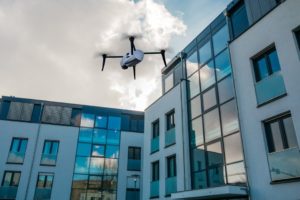
Drone-based aerial intelligence provider Kespry has announced the launch of high-resolution thermal inspection capabilities for commercial property and industrial facilities.
“Thermal building inspection is critical for organizations as they look to reduce investment risk in the $750 billion combined commercial real estate, insurance, and management industry,” a Kespry spokesperson said, adding – “until today, property managers, owners, and insurers were forced to rely on expensive and inaccurate manual inspections or low-resolution, first-generation drones to determine the health of a roof.”
An autonomous drone inspect product can greatly reduce inspection costs and create safer conditions for workers who before would have to climb dangerous heights to perform the same task.
Kespry CEO George Mathew explains:
“Accuracy really matters when billions of dollars of property and facilities are at risk. Manual inspections and first-generation drone flights are slow and inaccurate ways of attempting to understand the state of a roof and the risk that issues may have on organizations’ productivity. These earlier approaches leave surveyors, risk assessors, and roof inspectors guessing at the specific location of leaks, blocked drains, or damage to building infrastructure, all of which can have serious impacts on assets inside. The new Kespry solution for commercial roof inspection solves these problems.”
The thermal inspection system relies on radiometric temperature analysis, a process that provides useful data to building inspectors.
“Radiometric analysis means that a specific temperature is displayed for a specific point on a roof,” a company statement explains. “In contrast, non-radiometric thermal drone data simply shows general temperature differences and changes in an area, making it hard to determine whether there is a specific point of damage or concern.”
In April, Kespry launched other enhancements to its line of drone building-inspection products with on-site processing of data, a Virtual Test Square (VTS) to support insurance claims decision-making, and enhanced automated hail detection – all driven by machine learning.
“For insurance carriers and their clients, the faster an accurate roof damage assessment can happen, the better. Touchless claims will rapidly become the industry standard,” Mathew said.
Jason is a longstanding contributor to DroneLife with an avid interest in all things tech. He focuses on anti-drone technologies and the public safety sector; police, fire, and search and rescue.
Beginning his career as a journalist in 1996, Jason has since written and edited thousands of engaging news articles, blog posts, press releases and online content.
Email Jason
TWITTER:@JasonPReagan
Subscribe to DroneLife here.